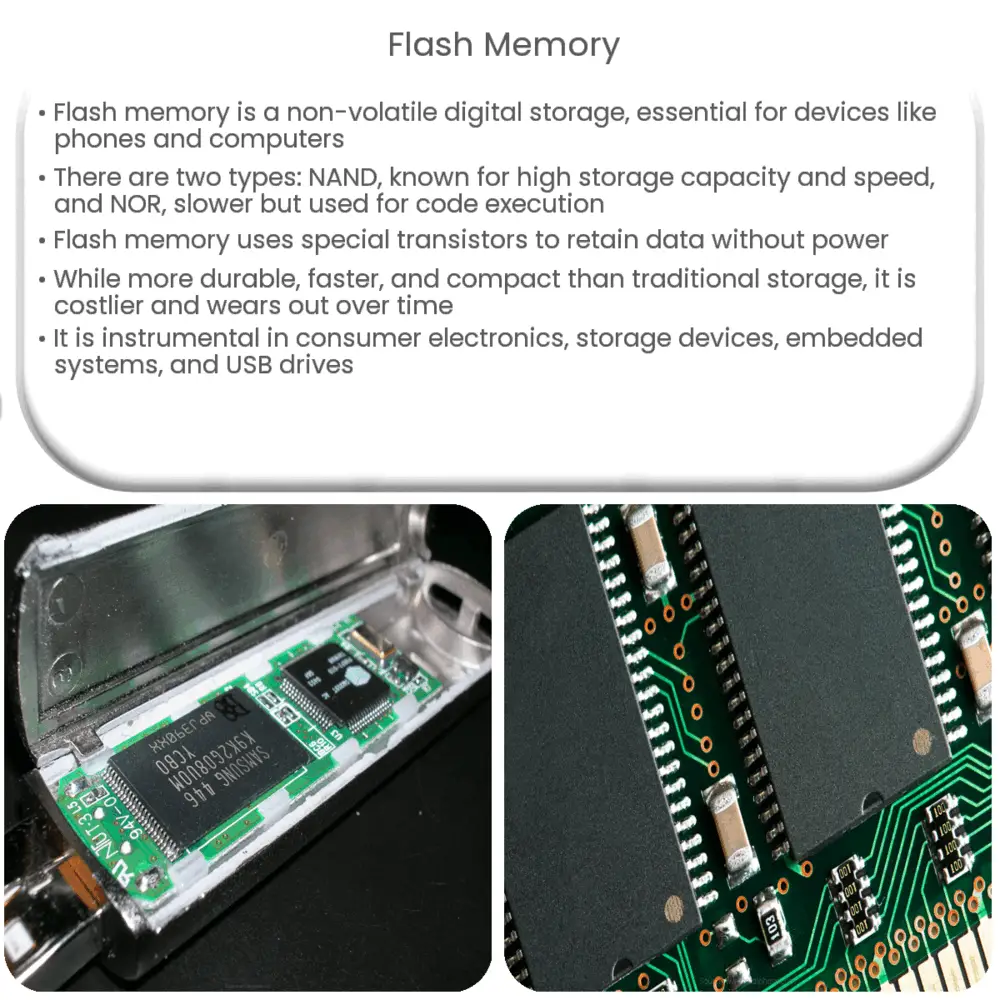Explore the world of flash memory: its types, working principle, pros & cons, applications, and future potential in this detailed guide.

Understanding Flash Memory
Flash memory is a form of non-volatile digital storage that can be electronically erased and reprogrammed. It is a technological marvel that plays an essential role in many of our day-to-day devices like mobile phones, tablets, cameras, and increasingly, computers. Its ability to maintain stored data without a power source has made it a prevalent choice for many digital storage applications.
Types of Flash Memory
- NAND Flash Memory: NAND flash memory is known for its high storage capacity and is widely used in larger devices such as SSDs (Solid State Drives), smartphones, and digital cameras. This type of flash memory reads and writes data in small blocks, making it faster and more efficient.
- NOR Flash Memory: Unlike NAND, NOR flash memory is typically used for code execution in devices like PDAs, cell phones, and embedded systems. NOR flash memory reads data byte by byte, which makes it slower when compared to NAND.
Understanding the Working Principle of Flash Memory
The fundamental building block of flash memory is the memory cell. A memory cell is a special type of transistor that can store a bit of data as a 0 or 1. A flash memory chip consists of a vast array of these cells organized into a grid.
Flash memory utilizes floating gate transistors to store data. Each of these transistors contains a floating gate, which can hold a charge, and a control gate. By manipulating the charge of the floating gate, we can represent binary data.
It’s essential to understand that flash memory’s non-volatile nature is due to the unique structure of these transistors. When the power source is disconnected, the charge on the floating gate remains unchanged, ensuring that the stored data is retained.
Advantages and Disadvantages of Flash Memory
Flash memory comes with an array of benefits and drawbacks, making it an ideal choice for certain applications while presenting challenges for others.
- Durability: Flash memory is far more durable and reliable than traditional storage mediums such as Hard Disk Drives (HDDs). Without any moving parts, flash memory is less likely to fail due to physical shock or wear and tear.
- Speed: When it comes to accessing data, flash memory significantly outpaces traditional storage methods. This high-speed data access makes flash memory ideal for devices where quick data retrieval is crucial.
- Size: Flash memory chips are compact, making them an excellent choice for mobile and handheld devices.
- Cost: One of the most significant disadvantages of flash memory is the cost. Flash memory is generally more expensive per gigabyte compared to HDDs.
- Lifespan: Flash memory cells wear out after a certain number of write cycles. This means that over time, the reliability of flash memory decreases.
Applications of Flash Memory
Flash memory is used in a multitude of applications, many of which are instrumental in our everyday life. A few of these applications are discussed below:
- Consumer Electronics: From smartphones, tablets, digital cameras to portable music players, flash memory has found its way into numerous consumer electronic devices. The compact size, high speed, and non-volatility make flash memory an excellent fit for these applications.
- Storage Devices: Solid State Drives (SSDs) are increasingly replacing traditional Hard Disk Drives (HDDs) in computers due to their superior speed and durability, and it’s all thanks to flash memory.
- Embedded Systems: In the world of embedded systems, flash memory is used to store the firmware that runs the device. The non-volatile nature of flash memory ensures that the device can retain its programming even when power is lost.
- USB Flash Drives: USB flash drives, or thumb drives, have replaced CDs and DVDs as the preferred medium for transporting data due to their portability, durability, and large storage capacity.
Flash Memory and the Future
As technology continues to advance, so does the demand for more efficient, reliable, and faster storage solutions. Newer technologies like 3D NAND are pushing the boundaries of flash memory technology, offering higher storage capacities and increased performance. The rapid advancements in flash memory technology make it an exciting field to watch, as it continues to shape the future of digital storage.
Conclusion
In conclusion, flash memory has revolutionized digital storage with its non-volatile nature, high-speed data access, and compact size. Despite its few drawbacks, such as cost and lifespan limitations, flash memory continues to be an integral component of numerous electronic devices, from our smartphones to our computers. As flash memory technology continues to advance, we can expect to see even greater enhancements in digital storage and device performance. The future of flash memory, it seems, is a bright and promising one.

